CONMERCIAL MOTOR ROADTEST: VOLVO VN Price! UK equivalent £90,000 Engine: 12-litres, 425hp (317kVV).
Page 20
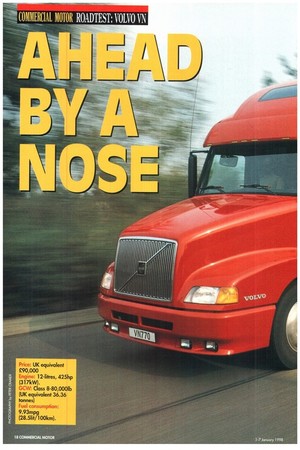
Page 21
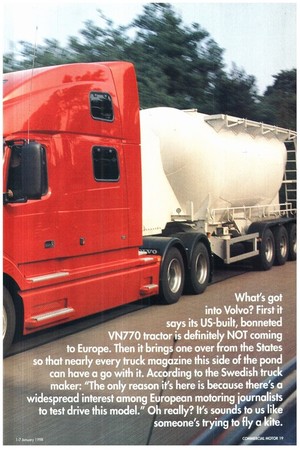
Page 22
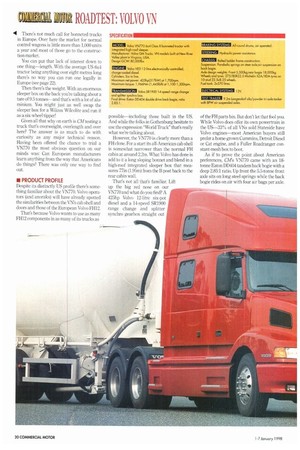
Page 23

Page 24
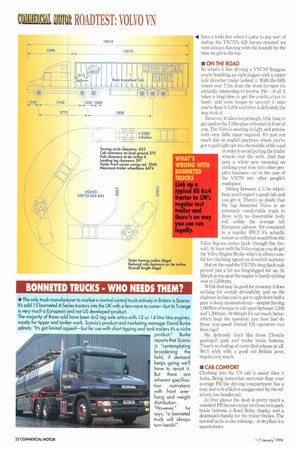
Page 25
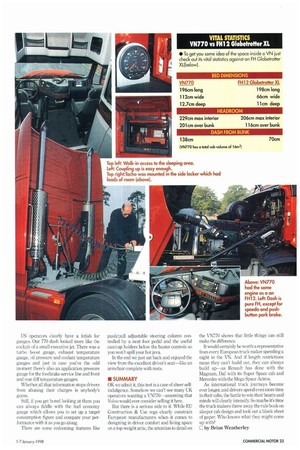
If you've noticed an error in this article please click here to report it so we can fix it.
GCW Class 8-80,000Ib (UK equivalent 36.36 tonnes) Fuel consumption: 9.93mpg (28.514/100km).
What's got
sow' into Volvo? First it
mow says its US-built, bonneted * VN770 tractor is definitely NOT coming to Europe. Then it brings one over from the States so that nearly every truck magazine this side of the pond can have a go with it. According to the Swedish truck maker: "The only reason it's here is because there's a widespread interest among European motoring journalists to test drive this model." Oh really? It's sounds to us like someone's trying to fly a kite.
41 There's not much call for bonneted trucks in Europe. Over here the market for normal control wagons is little more than 1,000 units a year and most of those go to the construction market.
You can put that lack of interest down to one thing—length. With the average US 6x4 tractor being anything over eight metres long there's no way you can run one legally in Europe (see page 22).
Then there's the weight. With an enormous sleeper box on the back you're talking about a
tare of 9.5 tonnes and that's with a lot of aluminium. You might just as well swap the sleeper box for a Wilcox Wilcolite and run it as a six-wheel tipper!
Given all that why on earth is CM testing a truck that's overweight, overlength and over here? The answer is as much to do with curiosity as any major technical reason. Having been offered the chance to trial a VN770 the most obvious question on our minds was: Can European manufacturers learn anything from the way that Americans do things? There was only one way to find out.
• PRODUCT PROFILE Despite its distinctly US profile there's something familiar about the VN770. Volvo operators (and anoraks) will have already spotted the similarities between the VN's cab shell and doors and those of the European Volvo FH12.
That's because Volvo wants to use as many FH12 components in as many of its trucks as possible—including those built in the US. And while the folks in Gothenburg hesitate to use the expression "World Truck" that's really what we're talking about.
However, the VN770 is clearly more than a FH clone. For a start its all-American cab shell is somewhat narrower than the normal FH cabin at around 2.2m. What Volvo has done is add to it a long sloping bonnet and blend in a high-roof integrated sleeper box that measures 77in (1.95m) from the 13 post back to the rear cabin wall.
That's not all that's familial.. Lift
up the big red nose on our VN770 and what do you find? A 425hp Volvo 12-litre six-pot diesel and a 14-speed SR1900 range change and splitter synchro gearbox straight out
of the FH parts bin. But don't let that fool you. While Volvo does offer its own powertra in in the US-33% of all VNs sold Stateside have Volvo engines—most American buyers still prefer a home-grown Cummins, Detroit Diesel or Cat engine, and a Fuller Roadranger constant-mesh box to boot.
As if to prove the point about American preferences, ars VN770 came with an 18tonne Eaton DD404 tandem back bogie with a deep 2,85:1 ratio. Up front the 5.5-tonne front axle sits on long steel springs while the back bogie rides on air with four air bags per axle.
With its whopping 5.77m wheelbase, long ladder frame, twin 570-litre fuel tanks and a ginormous cab, the VN770 tips the scales at a heart-stopping 9,580kg! What do they say about overweight Americans...?
As for that sleeper box, for a full description see our "Big Night Out" section (right).
Although Volvo managed to wangle a dispensation to run a 8.7m tractor in Europe in order to stay within the 16.5m overall length limit our VN70 was coupled to a 9.2 metre triaxle bulk powder tanker.
• PRODUCTIVITY
They say everything's supposed to be bigger in America. Strangely that doesn't include truck weights. While there are local variations between states, the national interstate limit for Class 8 (top weight) artics is a wimpish 80,000lb or 36.36 tonnes, which was what our rig ran out at. Take 9.58 tonnes off for your 111\1770, and eight tonnes for our triaxle tank test trailer, and you're looking at a "payload" of 18.78 tonnes,...hmmmm. You'd earn more with an old Ihno eight-legger, We've probably been brainwashed by tales of gas-guzzling American cars but around our special test route, which included some nasty little B-roads and town work and a long jog down the M3, the VN770 returned a surprisingly good 9.93inpg overall (28.451it/100km). On the motorway that rose to 11.41mpg (21.76a/100km) although on urban v,rork it fell back to a less frugal 6.24mpg (45.291it/100km). But let's face, with a slippery aerodynamic front end, a smooth tanker and one and a half tonnes light on the back it ought to do well.
As we weren't running around our usual CM Scottish test route average speed figures mean little. We'll just say that at a steady 56mph there seemed to be a awful lot of wagons passing us on the flat • have a look) but when it came to any sort of incline the VN770's 425 horses ensured we were always hunting with the hounds by the time we got to the top.
• ON THE ROAD So what's it like driving a VN770? Imagine you're handling an eight-legger with a centre axle drawbar trailer behind it. With the fifth wheel over 7.1m from the front bumper it's certainly interesting to reverse. Finr of all it takes a long time to get the combiLation to bend—and even longer to unwind it once you've done it. Little and often is definitely the way to do it.
However, it takes surprisingly little time to get used to the 1.35m-plus of bonnet in front of you. The Volvo's steering is light and precise with very little input required. It's just not much fun on angled junctions where you've got to pull right out into the middle of the mad in order to avoid putting the trailer wheels over the kerb. And that puts a whole new meaning on sticking your nose into other people's business—or in the case of the VN770 into other people's roadspace.
Sitting between a 5.1m wheelbase you'd expect a good ride and you get it. There's no doubt that the big bonneted Volvo is an extremely comfortable truck to drive with no discernible body roll, unlike the average tall European cabover. Yet compared to a regular FH I 2 it's actually noisier as reflected sound from the Volvo big-six comes back through the firewall. At least with the Volvo engine you do get the Volvo Engine Brake which is always useful for checking speed on downhill sections.
Out on the road the VN770's deep back axle proved just a bit too long-legged for us. At 56mph in top gear the engine is barely ticking over at 1,200rpm.
While that may be good for economy it does nothing for overall driveability and on the slightest incline you've got to split down half a gear to keep momentum up—despite having 1,966Nm of torque to call upon between 1,100 and 1,300rpm. At 60mph it's not much better, which begs the question: just how fast do those non-speed limited US operators run their rigs?
We definitely don't like those US-style push/pull park and trailer brake buttons. There's no feeling of controlled release at all. We'll stick with a good old British lever, thanks very much.
• CAB COMFORT Climbing into the VN cab is easier than it looks. Being somewhat narrower than your average FH the driving compartment has a cosy feel to it which is exaggerated by the relatively low header rail.
At first glance the dash is pretty much a standard FH layout except for those twin park brake buttons, a Road Relay display and a deadman's handle for the trailer brakes. The normal tacho is also missing-in its place is a speedometer. US operators clearly have a fetish for gauges. Our 770 dash looked more like the cockpit of a small executive jet. There was a turbo boost gauge, exhaust temperature gauge, oil pressure and coolant temperature gauges and just in case you've the odd moment there's also an application pressure gauge for the footbrake service line and front and rear diff temperature gauges.
Whether all that information stops drivers from abusing their charges is anybody's guess.
Still, if you get bored looking at them you can always fiddle with the fuel economy gauge which allows you to set up a target consumption figure and compare your performance with it as you go along.
There are some redeeming features like push/pull adjustable steering column controlled by a neat foot pedal and the useful can/cup holders below the heater controls so you won't spill your hot java.
In the end we just sat bark and enjoyed the view from the excellent driver's seat—like an armchair complete with rests.
• SUMMARY OK we admit it, this test is a case of sheer selfindulgence. Somehow we can't see many UK operators wanting a VN770—assuming that Volvo would ever consider selling it here.
But there is a serious side to it. While EU Construction & Use regs clearly constrain European manufacturers when it comes to designing in driver comfort and living space on a top-weight artic, the attention to detail on the VN770 shows that little things can still make the difference, It would certainly be worth a representative from every European truck maker spending a night in the VN. And if length restrictions mean they can't build out, they can always build up—as Renault has done with the Magnum, Daf with its Super Space cab and Mercedes with the Mega Space Actros.
As international truck journeys become ever longer, and drivers spend even more time in their cabs, the battle to win their hearts and minds will clearly intensify. So maybe it's time the truck makers threw away the rule book on sleeper cab design and took out a blank sheet of paper. Who knows what they might come up with?
E by Brian Weatherley SPECIFICATION
Mal Volvo VN770 6.4 Class 8 bonneted tractor with integrated high-roof sleeper. Manufacturer: Volvo GM Trucks. VN models built at New River Valley plant in Virginia, USA.
Design GCW 80,000Ibs Mal Volvo VED 12-litre electronically-controlled, charge-cooled diesel.
Cylinders: Six-in line_ Maximum net power: 425hp4317kW) at 1,700rpm. Maximum torque: 1,966Nm (1,4451E40 at 1,100-1,300rpm.
MIME! Volvo SR1900 14-speed range change and splitter synchro box.
Final drive: Eaton DD404 double drive hack bogie, rotio 2.85:1. EMEHEIRM Ail-round drums, air operated. P.MTIMI Hydraulic power assistonce.
SEIM Bolted ladder frame construction
Suspension: Parabolic springs on steer axle;air suspension on back bogie.
Axle design weights: Front 5,500kg;reor bogie 18,000kg. Wheels and tyres: 275/80R22.5 Michelin XZA/XDA tyres on 10-stud 22.5.8.25 wheels.
Fuel tank: 2.570 litres ELECTRICAL SYSTEMS. 12V.
TEST TRAILER: 9.2m Langendorf silo/powder tri -axle tanker with BPW air suspended axles.
VN 770 SLEEPER: A BIG NIGHT OUT
When Volvo offered us the chance to test the VN it seemed only sensible to spend the night in it. After all, we don't get to sleep in cabs this big every day although it's more like a small
bungalow. If you've ever struggled to get your trousers on in an FL10 then this is the wagon for you. With the engine out front the VN770 has an unrestricted flat floor. Which means that when you want to get your head down you simply park up, stand up and walk, yes walk, back into the sleeping area. There's no crawling over on engine hump, no tripping over a gear lever, no struggling with nets—at last freedom!
The VN bunk base doubles neatly as a coffee table (just in case you've invited a few Friends over). To set up the bed you simply lower the table to form a bridge between the two side sofas, re-lay the cushions and hey presto you've got a double bed.
Of course before you turn in you'll want to satisfy the inner man. And with a built in microwave oven you can whip up a three-course meal for one in no time. Keeping food fresh is no problem either, thanks to the enormous 80-litre capacity fridge. Then how about a video? Just slip in the cassette and watch the 19in telly from the comfort L .../ of your bed. Or you could always listen to your CD player. At last we've found a truck with all the storage space you'll ever need from the built-in wardrobe big enough for Brian Rix to hide in (minus trousers) to the sliding drawers,
(not least to 01.. wall cupboards, lockers, shelves, cubbyholes and if that's not enough, outside there' s the biggest chain locker we've ever seen which is deep enough to take a medium-size canoe. But oh, the absolute bliss of being able to get undressed standing up straight rather than like some hunchback. And then hanging up your clothes ready for the next day—suddenly you begin to see why US drivers are prepared to spend weeks on the road in cabs like this.
After drawing the thick full length curtains that separate the sleeping compartment From the driving area (they could have used patio doors) we settled down for the night.
Even then there was still time to be impressed by the handy bedside cup holders, the reading lamp, central master switch for the lights and the two 1 2v sockets by the bed—after a razor what on earth is the other one for...?
As we drifted off to sleep our only thought was why can't all trucks be like this?
BONNETED TRUCKS • WHO NEEDS THEM?
• The only truck manufacturer to market a normal control truck actively in Britain is Scania. It's sold 15 bonneted 4-Series tractors into the UK with a few more to come—but its T-range is very much a European and not US developed-product.
The majority of those sold have been 6x2 tag axle artics with 12 or 14-litre litre engines, mostly for tipper and tanker work. Scania's product and marketing manager David Burke admits: "It's got limited appeal—but for use with short tipping and tank trailers it's a niche
product. liurke
reports that Scania is "contemplating broadening the field, if demand keeps going we'll have to revisit it But there are inherent specifica
tion restrictions with front overhang and weight distribution.
"However," he says, "a bonneted truck will always turn heads!"
















































































